Comic Strip Spread
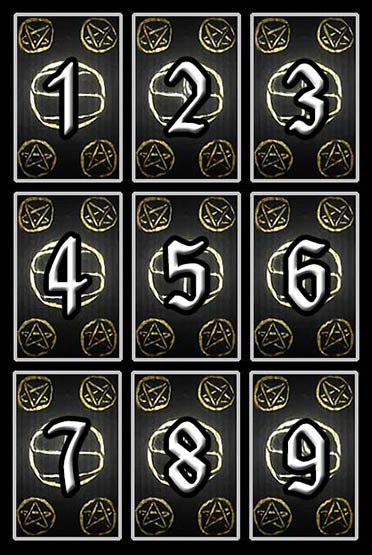
Difficulty: Easy
Note: This spread works best with decks like the Diary of a Broken Soul or Surrealist Tarot because they display scenes rather than pips and do not use reversals.
The Comic Strip Spread is a simple nine-card chronological spread that looks like a page of a comic book. This method should be used to get a glimpse of the future as it would pan out naturally. It may be insightful to use this spread in coordination with biorhythms. The spread is easy to read as a storyboard, just like a comic strip.
The main subject is apparent in the first card, while the story plays out through the following tarot cards.
It is important to pay particular attention to the cards and the relationships with their neighbours. Notice which directions the cards are facing, and how they interact.
Your Comic Strip Reading
Two of Cups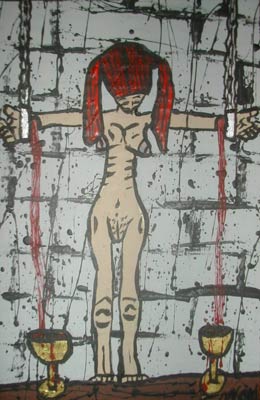 |
Ten of Stakes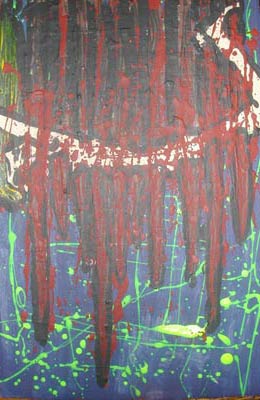 |
XVII. The Star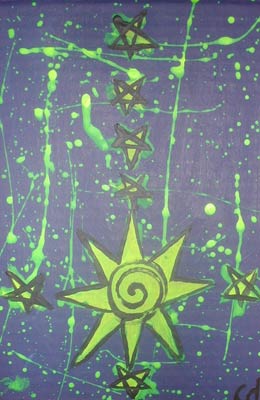 |
XI. Justice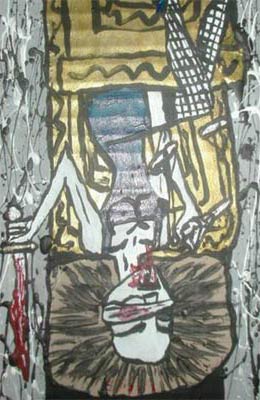 |
XXI. The World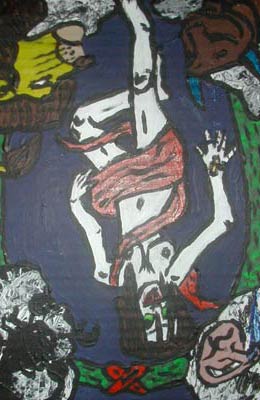 |
King of Cups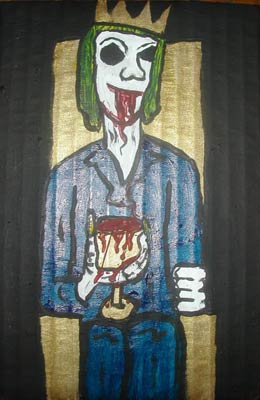 |
Five of Pentagrams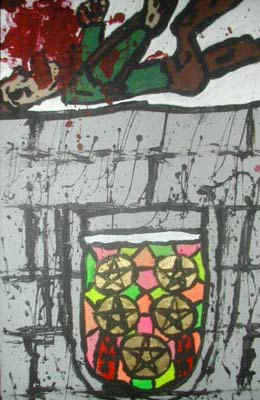 |
Eight of Pentagrams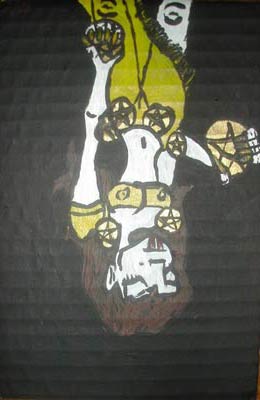 |
Ten of Cups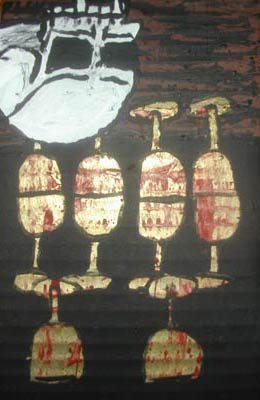 |

Card 1: Two of Cups
Symbolism:
A young, nude female chained to a dungeon wall is drained of her life force, which fills two cups symbolic of a master's love for bloodlust. The connection between the figures emphasizes emotional entanglement, power dynamics, and the intertwined nature of love and suffering.
Meaning:
The Two of Cups is a card of deep emotional connection, partnership, and harmony. It signifies love, mutual respect, and the bonding between two individuals, whether in a romantic or platonic context. It is the union of two hearts, often indicating the beginning of a significant relationship or partnership.
Keywords:
Upright: Love, partnership, harmony, mutual respect, emotional connection.

Card 2: Ten of Stakes
Reversed
Symbolism:
Amidst a sea of blood and carnage, a corpse is barely discernible, overshadowed by the horror of the scene. The sheer brutality suggests the weight of betrayal, excessive burdens, or a struggle too great to bear.
Meaning:
The Ten of Stakes signifies the culmination of challenges and the weight of responsibilities. It warns of being overburdened or taking on too much. This card serves as a reminder to reassess priorities and delegate tasks when necessary. While it reflects exhaustion, it also suggests that an end to the struggle is near.
Reversed, the card warns of oppression, excessive force, or bad luck. It may also indicate that you are holding on to burdens that could be released.
Keywords:
Reversed: Oppression, brutality, bad luck, overextension, relief.

Card 3: XVII. The Star
Symbolism:
The Star depicts a luminous vampire bathing in a moonlit pool, her pale skin shimmering with starlight. She pours blood from a goblet into the water, symbolizing renewal and the cycle of life. Above her, a constellation forms the shape of a chalice, representing hope and inspiration. The night sky is clear, and the surrounding landscape, though desolate, begins to show signs of new growth.
Meaning:
The Star embodies hope, inspiration, and spiritual renewal. It encourages you to trust in the universe and your own inner light, even during challenging times. This card often appears after a period of struggle, signaling healing, clarity, and the promise of brighter days ahead.
Keywords:
Upright: Hope, inspiration, renewal, clarity, healing, optimism, spirituality, guidance.

Card 4: XI. Justice
Reversed
Symbolism:
Justice is depicted as a pale, vampiric figure holding a pair of scales in one hand and a blood-stained sword in the other. One side of the scale holds a black feather, while the other holds a human heart, symbolizing the balance between moral accountability and emotional truth. Her blindfold is sheer, hinting at impartiality tempered with insight. Behind her, a blood-red curtain reveals fragmented mirrors reflecting distorted truths.
Meaning:
Justice embodies fairness, truth, and accountability. She calls for honesty and objectivity in your actions and decisions, ensuring that you consider all perspectives before rendering judgment. This card often signals the need to weigh your choices carefully and to take responsibility for the consequences of past actions.
Reversed, Justice suggests imbalance, dishonesty, or unfair treatment. It may indicate a refusal to acknowledge the truth or an avoidance of accountability for your actions.
Keywords:
Reversed: Dishonesty, unfairness, imbalance, corruption, denial of truth, avoidance.

Card 5: XXI. The World
Reversed
Symbolism:
The World depicts a powerful figure standing within a glowing circle of blood-red roses, symbolizing completion and unity. The four corners of the card feature elemental creatures: a bat, a wolf, a raven, and a serpent, representing balance and harmony among all forces. A starry night sky stretches infinitely behind the figure, while they hold a silver orb and a golden key, symbolizing mastery and fulfillment.
Meaning:
The World represents completion, fulfillment, and the achievement of long-term goals. It signifies harmony, wholeness, and the realization of your place in the greater tapestry of existence. This card often marks the end of a significant journey, celebrating your success and inviting you to share your gifts with others.
Reversed, the World suggests delays, unfinished business, or feelings of incompleteness. It may indicate the need to tie up loose ends before moving forward.
Keywords:
Reversed: Delays, lack of closure, incompletion, stagnation, unfinished business, imbalance.

Card 6: King of Cups
Symbolism:
Seated upon his throne, the King clasps a full chalice in hand. The King embodies emotional mastery, wisdom, and balance, symbolizing the ability to rule over emotions and guide others with compassion.
Meaning:
The King of Cups represents emotional maturity, control, and wisdom. He is a master of his feelings and uses his emotional intelligence to guide others. This card signifies someone who is emotionally stable, compassionate, and deeply understanding. The King offers counsel, support, and emotional protection to others and is often a symbol of balance in relationships and emotional wellbeing.
Keywords:
Upright: Emotional maturity, wisdom, stability, compassion, emotional intelligence, guidance.

Card 7: Five of Pentagrams
Reversed
Symbolism:
Outside of the devil's church, a vampire lies in a heap of his own vomit, symbolizing excess, indulgence, and the consequences of material excess. The scene reflects the dangers of overindulgence and losing control.
Meaning:
The Five of Pentagrams represents material loss, poverty, and hardship. It signifies a time of struggle, where one may feel destitute or faced with overwhelming financial or personal challenges. It warns of consequences from reckless decisions and suggests that emotional support or help may be needed to overcome this period.
Reversed, it points to chaos, insecurity, and failed endeavors. It may indicate that the situation is worsened by your own actions or choices, leading to ruin, envy, or bad outcomes.
Keywords:
Reversed: Chaos, ruin, envy, insecurity, wasted opportunities.

Card 8: Eight of Pentagrams
Reversed
Symbolism:
An exotic dancer adorned in pentagrams performs, her act representing craftsmanship and skill. She embodies the dedication to her craft, with a focus on discipline and mastery.
Meaning:
The Eight of Pentagrams speaks to hard work, craftsmanship, and the pursuit of excellence. It suggests a time of preparation and dedication to one's skills. Whether in a professional or personal capacity, this card encourages you to continue honing your abilities and remain committed to your goals.
Reversed, it may indicate unfulfilled ambition, vanity, or the exploitation of one's skills for selfish gain. It warns against focusing on appearance over substance or engaging in unethical practices.
Keywords:
Reversed: Vanity, exploitation, unethical behavior, unfulfilled ambition.

Card 9: Ten of Cups
Reversed
Symbolism:
Ten used cups sit in storage, while a skull watches over them. The imagery suggests a sense of completion, fulfillment, and the closing of a chapter, but also a reminder that all things come to an end.
Meaning:
The Ten of Cups represents emotional fulfillment, contentment, and happiness in relationships. It is the ultimate expression of emotional satisfaction, often symbolizing harmony in family life, long-lasting love, or the completion of an emotional journey. It suggests a sense of peace and joy, where all emotions align, and dreams come true.
Reversed, this card warns of emotional disconnection or the end of a previously harmonious situation. It may indicate broken relationships, family conflicts, or feelings of dissatisfaction despite outward appearances.
Keywords:
Reversed: Disconnection, broken relationships, emotional dissatisfaction, family conflicts.
